|
|
|
India's varied
environment is the home of the vast range
of animals and some rare species of birds like Rufous-
chinned
and white crested laughing thrush, rufous-
breasted accentor,
greater yellow-naped flameback,
blue whistling thrush and red-billed blue magpie. |
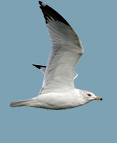 |
|
|
Birds in India |
|
Great Cormorant
Although less restricted to lowland waters, the Great
Cormorant is neither as numerous nor as gregarious as
its smaller relatives. Cormorants hunt fish by diving
from the surface, often making a little upward jump
first. The stiff tail is used as a rudder under water.
Despite being aquatic birds, their plumage is coarse and
not particularly water-resistant, and much time is spent
on sandbanks or tree-stumps with the wings held out to
dry. It occurs throughout the area, breeding in large
waterside colonies. |
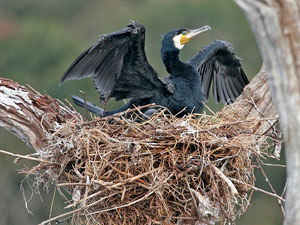 |
|
| |
|
Darters
Darters are the most highly specialized of underwater fishers.
They swim with the body submerged, the small head and sinuous
neck resulting in its other name of Snakebird. Fish are
speared with a sudden straightening of the neck, the curiously
formed neck bones acting like a trigger. Darters are less
sociable than Cormorants, and often seen singly. They are
strong fliers, frequently soaring, the long tail fanned out.
They breeds colonially in the lowlands.
Little
Cormorant
Little Cormorant is the most abundant of its family. It
gathers in huge numbers at some waterside breeding colonies
and also nests in trees in village compounds some way from
water. It constantly consorts with the Shag in a jostling,
splashing throng to hairy shoals of fish. It flies strongly,
the neck outstretched, the wing beats interspersed with short
glides. The nestlings are ugly and scrawny, and noisily pester
their parents to regurgitate the food in their crops, plunging
their bills in to feed.
Bar
–
Headed
Goose
Bar – Headed Goose are common in winters in northern and
central India, but rarer further south. Usually in large, wary
flocks on jheels or by rivers, it is frequently shot owing to
its depredations on crops. The flocks fly in a long,
strung-out V formation, and the wild musical honking is best
heard when the birds are fighting to or from their feeding
ground. It is known to fly at very high altitudes when on
migration over the Himalayas. |
| |
|
Little
Egret
The fashion for wearing “aigrettes” – the beautiful
plumes grown by egrets in the breeding season – nearly
led to its extinction in certain areas some years ago
happily, however, many remain in India to adorn the
marshes and jheels where they stalk about after fish,
frogs and insects. When feeding in shallow water they
sometimes dash about wildly probably to disturb their
prey. They fly with slow, steady flaps, the neck well
tucked in, and in large waterside colonies with other
species. They are resident throughout the area in the
plains and lower hills.
Grey
Heron
Grey Heron is a more solitary bird away from its
breeding colonies than the egrets, |
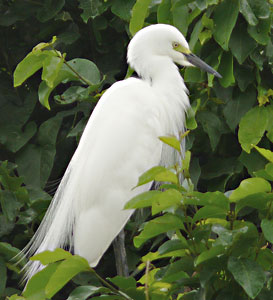 |
|
|
it is
nevertheless a familiar figure whether by lowland pond or hill
stream. A skilled and patient fisherman, its gawky shape is
distinctive when poised with neck outstretched at the water’s
edge, or when beating slowly across the sky on broad wings.
The large stick nests are usually placed in tall trees, or by
the water in reed beds or mangroves. The scraggy nestlings are
fed on regurgitated food, which they solicit by tugging at the
parent’s bill.
Painted Stork
Painted Stork can be seen at inland waters in the plains, it
is mainly a fish-eater, and often wades along with the
half-opened bill ploughing the water. Usually seen in small
numbers, except at the teeming breeding colonies.
White Stork
White Stork is a winter visitor to India, rarer in the south
than the north and west. Usually in small parties by jheels,
marshes or wet fields where a variety of food is taken,
including frogs and grasshoppers. Migrating flocks make use of
rising hot air currents – “thermals” – to soar and gain
height.
Adjutant Stork
Adjutant Stork is an impressive bird, whether stalking over
marshland, or soaring on its huge wings, often in company with
vultures. An avid scavenger of any refuse, offal or carcase,
it also feeds on fish, frogs or snakes. The function of the
curious inflatable neck pouch is not known, although it is
certainly not capable of storing food as might be imagined.
Nesting in Bangladesh and Assam, this stork wanders widely
across northern India. |
| |
|
Spoonbill
Its peculiar bill, flattened and broadened at the tip,
is adapted for feeding in shallow water. As the bird
moves for ward, the bill is swept from side to side,
sifting the bottom for small aquatic animals. They are
sociable and inactive. Spoonbills spend much of the day
standing around in marshes and swamps. They breed
colonially with herons and cormorants, and occur
throughout the |
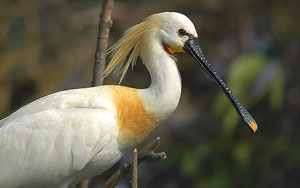 |
|
|
area.
Greater Flamingo
Like the Spoonbill, the Greater Flamingoes have a specialized
beak for sifting small animal matter from shallow water, but
does this by curving the long neck so that the bill is upside
down, pointing back at the feet, and moving it from side to
side. The only birding area known in India is in Kutch, where
many birds congregate to build their mud-pie nests on the salt
flats. In winter the birds may be seen on jheels throughout
the area; rarely in the east.
Cotton Teal
Cotton Teal is the smallest duck in the world. It is
widespread in the better watered areas of India except in the
south-west, although nowhere really abundant, Usually in pairs
or small flocks on weedy thanks or jheels, where it feeds on
water plants. The nest is placed in a hole in a tree. Although
not adapted at either diving or walking, it flies fast.
Monal
Monal, the magnificent pheasant haunts the upper valleys of
the Himalayas, rarely descending below about 2000 m, even in
winter. It is especially partial to the rocky alpine meadows
where they are interested by clumps of fir or rhododendron,
and here the birds dig for bulbs and roots with their powerful
beaks. They tend to keep in small parties, and are very shy,
shooting off down-hill when disturbed, with a loud whistling
call. When displaying, the cock fans and raises his rufous
tail, droops his wings to reveal the white back – patch, and
fluffs out the brilliant iridescent neck feathers.
Kalij Pheasant
Kalij Pheasant are the most familiar Himalayan pheasants,
being less restricted to high or remote areas. It occurs from
Kashmir to Bhutan and Assam in several different races, being
distinguished by the amount of white in the plumage. The white
– crested bird illustrated is from the west Himalayas, the
darker bird from Nepal. It is fond of the thick undergrowth of
jungle ravines. But also frequents cultivation around hill
villages. It is more active at dawn and dusk, and can then
sometimes be seen in clearings or along tracks. Small parties
keep in touch with a low clucking call, and the cock makes a
deep drumming noise when displaying by vibrating his wings
rapidly. |
| |
|
Sarus Crane
It is difficult to overlook this impressive and stately
bird – nearly as tall as a man – on the jheels and
marshes where it lives. It pairs for life, the two birds
always stating so close together as to have inspired
much folklore about their fidelity, and it by common
consent, allowed to live unmolested. It is, in
consequence, much less wary than the two migratory
cranes. It has a loud trumpeting call, uttered with the
neck and bill stretched up, the male |
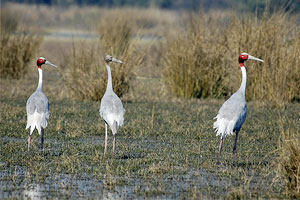 |
|
|
often
fluffing the back feathers and secondary up while pressing
the primaries stiffly down. One bird of a pair always answers
the other’s call. In the nuptial display the two birds dance
round each other with little jumps and bows, the whole
performance lasting several minutes. It is widely distributed
across northern India from Pakistan to Assam.
Common Crane
Grey cranes found in winter in flocks are likely to be of this
or the next species, both being migratory. The sight of a
large flock in flight to most impressive, being enhanced by
the loud resonant trumpeting calls. Found on flooded meadows
or jheels, cranes are constantly on the alert, and feed mostly
in the mornings and evenings in crops, where they can do much
damage. They visit the plains country of northern India
between October and March.
Demoiselle Crane
Breeds over a smaller area of Eurasia than the Common Crane,
but visits India in perhaps even larger numbers. Most common
in the north-west, becoming rare in the south and Bangladesh.
It prefers rather more arid and stony habitats to the larger
bird, although both species may often be found together.
Great Indian Bustard
Now becoming rare in the dry, open grasslands of north-west
India, it was once common and ranged through Pakistan and
Peninsular India. The spread of cultivation is one adverse
factor, but it is still shot from vehicles despite the evident
need for its preservation, as it occurs nowhere else in the
world. It is usually seen in small flocks, but they are very
shy and wary, and often prefer to run rather than fly when
disturbed. The male has an elaborate display when the neck
feathers are fluffed out and an inflatable pouch of skin
expanded, the tail is spread and elevated, and the wings
dropped, while he pirouettes around an apparently uninterested
hen. The male is about a third larger than the female, and
weights up to 14 kg.
Bengal Florican
Found in the grassland areas north and east of the Ganges. The
cock has a distinctive display flight, watched by several
hens, when he jumps into the air and floats slowly down again.
He also displays on the ground, strutting round the hen with
expanded tail. Although best adapted for funning or walking,
bustards have large powerful wings, and are strong, steady
fliers, holding the neck stretched out. Owing to their good
eating qualities, both this bird and the Likh are extensively
shot. |
| |
|
Coot
The most aquatic of the rail family, it has broad, flat
lobes along the sides of its toes, and paddles more
smoothly and efficiently than a Moorhen. When taking off
from the water, it has to patter along before getting
airborne properly, but then flies well. Frequents open
waters, gathering in large herds in winter in Pakistan
and the north-west. It is found throughout the area, the
resident population being |
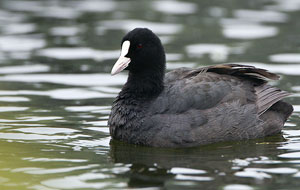 |
|
|
augmented by
winter visitors.
Purple Moorhen
It is fascinating to see this apparently heavy and clumsy rail
clambering about easily in reed-beds, grasping the stems with
its long toes. Rarely seen in flight, it spends most of the
time durking in thick, swampy vegetation, often in small
parties. It shares the family habit of flicking the tail up to
display the white coverts underneath. Found throughout the
area south of the Himalayas, but uncommon in Kashmir.
Common Sandpiper
Breeding by hill streams in the western Himalayas, Common
Sandpiper is a common winter visitor throughout the rest of
the area. Often seen singly on rocky or sandy river banks,
creeks, tank margins or the coast, it bobs nervously as it
moves about. When it flies out low over the water, the wings
look bowed, and are beaten shallowly to give a flickering
appearance.
Spotted Dove
Very widely distributed in southern Asia, Spotted Dove is
found throughout our area, frequenting rather lush wooded
countryside. It is a popular cage bird, and is familiar around
villages and gardens, where it walks about on the paths
picking up grain. It has a longer series of cooing phrases
than the Collared Dove.
Blue Rock Pigeon
Abundant around cities and towns throughout the area, there
are still wild populations of this pigeon, which live around
ruins or cliffs, feeding in nearby fields. The rich throaty
coo, and strutting, neck-swelling display of the cock are well
known to all. |
| |
|
Rose-Ringed Parakeet
The most abundant and well-known of its family, this
parakeet is to be found throughout the area in light
woodland, parks, gardens and cultivated areas. It is a
pest of some importance, as the noisy flocks do much
damage to crops and fruit. Although beautifully adapted
for climbing about in trees, with two toes pointing
forwards and two behind, they sometimes visit the
ground, sidling about with a rolling gait on their short
legs. The nest is placed in a hole in a tree, those with
small entrances being suitably enlarged, or sometimes in
cracks or holes in masonry. These and other parakeets
are favourite cage birds, but are not especially good at
learning to speak.
Jungle Owlet
More of a thick woodland and jungle dweller than the
spotted Owlet, Jungle Owlet occurs from the Himalayas
south to Sri Lanka, though not in the north-west. |
 |
|
| |
|
Common Kingfisher
Perhaps less shy than is larger relatives; this kingfisher is
found throughout the area. It is often to be seen perched on a
stick or branch overlooking a ditch or pool, watching intently
for fish. It nests in a tunnel by the waterside.
Great Pied Hornbill
Great Pied Hornbill occurs in small parties in forest in the
Himalayan foothills, North East, and South-west India, but is
declining in numbers as a result of de-forestation and
shooting. In flight, the wings make a loud droning sound –
often the only indication of the bird as it flies over
tree-tops in heavy forest, and it also has a loud, deep
cackling note. It is shy, and keeps much to the trees, only
rarely descending o the ground, and feeds largely on fruit.
Indian Pipit
Indian Pipit is common throughout the area, on short grass,
cultivated or fallow land. Generally in pairs or small
parties, it runs quickly over the grass to snap at a small
moth or beetle, then stretches upright to survey the
surroundings. Has a thin, double call-note. |
|